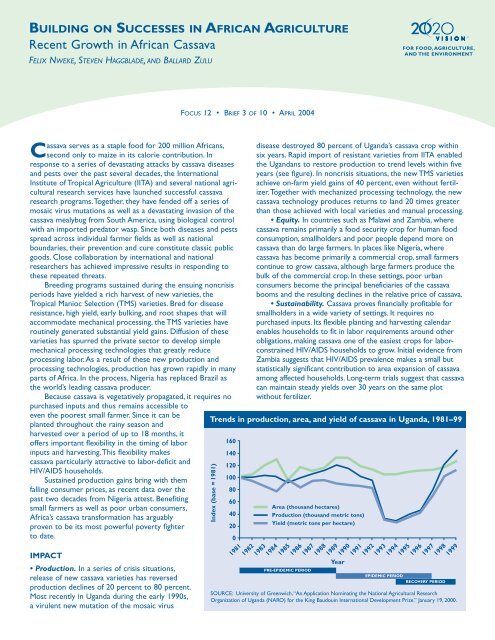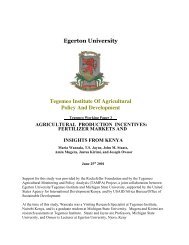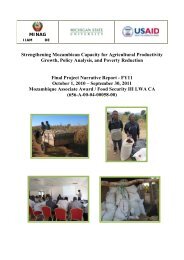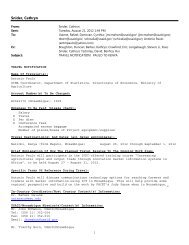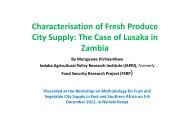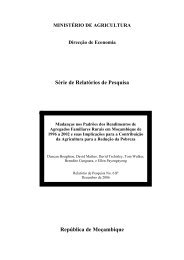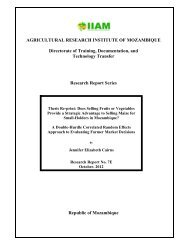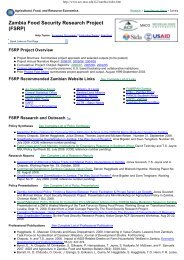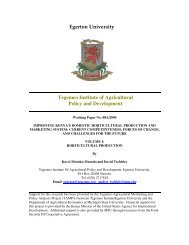Recent Growth in African Cassava - International Food Policy ...
Recent Growth in African Cassava - International Food Policy ...
Recent Growth in African Cassava - International Food Policy ...
Create successful ePaper yourself
Turn your PDF publications into a flip-book with our unique Google optimized e-Paper software.
BUILDING ON SUCCESSES IN AFRICAN AGRICULTURE<br />
<strong>Recent</strong> <strong>Growth</strong> <strong>in</strong> <strong>African</strong> <strong>Cassava</strong><br />
FELIX NWEKE,STEVEN HAGGBLADE, AND BALLARD ZULU<br />
FOR FOOD, AGRICULTURE,<br />
AND THE ENVIRONMENT<br />
FOCUS 12 • BRIEF 3 OF 10 • APRIL 2004<br />
<strong>Cassava</strong> serves as a staple food for 200 million <strong>African</strong>s,<br />
second only to maize <strong>in</strong> its calorie contribution. In<br />
response to a series of devastat<strong>in</strong>g attacks by cassava diseases<br />
and pests over the past several decades, the <strong>International</strong><br />
Institute of Tropical Agriculture (IITA) and several national agricultural<br />
research services have launched successful cassava<br />
research programs.Together, they have fended off a series of<br />
mosaic virus mutations as well as a devastat<strong>in</strong>g <strong>in</strong>vasion of the<br />
cassava mealybug from South America, us<strong>in</strong>g biological control<br />
with an imported predator wasp. S<strong>in</strong>ce both diseases and pests<br />
spread across <strong>in</strong>dividual farmer fields as well as national<br />
boundaries, their prevention and cure constitute classic public<br />
goods. Close collaboration by <strong>in</strong>ternational and national<br />
researchers has achieved impressive results <strong>in</strong> respond<strong>in</strong>g to<br />
these repeated threats.<br />
Breed<strong>in</strong>g programs susta<strong>in</strong>ed dur<strong>in</strong>g the ensu<strong>in</strong>g noncrisis<br />
periods have yielded a rich harvest of new varieties, the<br />
Tropical Manioc Selection (TMS) varieties. Bred for disease<br />
resistance, high yield, early bulk<strong>in</strong>g, and root shapes that will<br />
accommodate mechanical process<strong>in</strong>g, the TMS varieties have<br />
rout<strong>in</strong>ely generated substantial yield ga<strong>in</strong>s. Diffusion of these<br />
varieties has spurred the private sector to develop simple<br />
mechanical process<strong>in</strong>g technologies that greatly reduce<br />
process<strong>in</strong>g labor.As a result of these new production and<br />
process<strong>in</strong>g technologies, production has grown rapidly <strong>in</strong> many<br />
parts of Africa. In the process, Nigeria has replaced Brazil as<br />
the world’s lead<strong>in</strong>g cassava producer.<br />
Because cassava is vegetatively propagated, it requires no<br />
purchased <strong>in</strong>puts and thus rema<strong>in</strong>s accessible to<br />
even the poorest small farmer. S<strong>in</strong>ce it can be<br />
planted throughout the ra<strong>in</strong>y season and<br />
harvested over a period of up to 18 months, it<br />
offers important flexibility <strong>in</strong> the tim<strong>in</strong>g of labor<br />
160<br />
<strong>in</strong>puts and harvest<strong>in</strong>g.This flexibility makes<br />
140<br />
cassava particularly attractive to labor-deficit and<br />
120<br />
HIV/AIDS households.<br />
Susta<strong>in</strong>ed production ga<strong>in</strong>s br<strong>in</strong>g with them<br />
100<br />
fall<strong>in</strong>g consumer prices, as recent data over the<br />
80<br />
past two decades from Nigeria attest. Benefit<strong>in</strong>g<br />
60<br />
small farmers as well as poor urban consumers,<br />
40<br />
Africa’s cassava transformation has arguably<br />
proven to be its most powerful poverty fighter<br />
20<br />
to date.<br />
0<br />
IMPACT<br />
• Production. In a series of crisis situations,<br />
release of new cassava varieties has reversed<br />
production decl<strong>in</strong>es of 20 percent to 80 percent.<br />
Most recently <strong>in</strong> Uganda dur<strong>in</strong>g the early 1990s,<br />
a virulent new mutation of the mosaic virus<br />
disease destroyed 80 percent of Uganda’s cassava crop with<strong>in</strong><br />
six years. Rapid import of resistant varieties from IITA enabled<br />
the Ugandans to restore production to trend levels with<strong>in</strong> five<br />
years (see figure). In noncrisis situations, the new TMS varieties<br />
achieve on-farm yield ga<strong>in</strong>s of 40 percent, even without fertilizer.Together<br />
with mechanized process<strong>in</strong>g technology, the new<br />
cassava technology produces returns to land 20 times greater<br />
than those achieved with local varieties and manual process<strong>in</strong>g.<br />
• Equity. In countries such as Malawi and Zambia, where<br />
cassava rema<strong>in</strong>s primarily a food security crop for human food<br />
consumption, smallholders and poor people depend more on<br />
cassava than do large farmers. In places like Nigeria, where<br />
cassava has become primarily a commercial crop, small farmers<br />
cont<strong>in</strong>ue to grow cassava, although large farmers produce the<br />
bulk of the commercial crop. In these sett<strong>in</strong>gs, poor urban<br />
consumers become the pr<strong>in</strong>cipal beneficiaries of the cassava<br />
booms and the result<strong>in</strong>g decl<strong>in</strong>es <strong>in</strong> the relative price of cassava.<br />
• Susta<strong>in</strong>ability. <strong>Cassava</strong> proves f<strong>in</strong>ancially profitable for<br />
smallholders <strong>in</strong> a wide variety of sett<strong>in</strong>gs. It requires no<br />
purchased <strong>in</strong>puts. Its flexible plant<strong>in</strong>g and harvest<strong>in</strong>g calendar<br />
enables households to fit <strong>in</strong> labor requirements around other<br />
obligations, mak<strong>in</strong>g cassava one of the easiest crops for laborconstra<strong>in</strong>ed<br />
HIV/AIDS households to grow. Initial evidence from<br />
Zambia suggests that HIV/AIDS prevalence makes a small but<br />
statistically significant contribution to area expansion of cassava<br />
among affected households. Long-term trials suggest that cassava<br />
can ma<strong>in</strong>ta<strong>in</strong> steady yields over 30 years on the same plot<br />
without fertilizer.<br />
Trends <strong>in</strong> production, area, and yield of cassava <strong>in</strong> Uganda, 1981–99<br />
Index (base = 1981)<br />
1981<br />
1982<br />
1983<br />
1984<br />
Area (thousand hectares)<br />
Production (thousand metric tons)<br />
Yield (metric tons per hectare)<br />
PRE-EPIDEMIC PERIOD<br />
1985<br />
1986<br />
1987<br />
1988<br />
1989<br />
Year<br />
1990<br />
1991<br />
1992<br />
1993<br />
1994<br />
1995<br />
1996<br />
1997<br />
1998<br />
1999<br />
EPIDEMIC PERIOD<br />
RECOVERY PERIOD<br />
SOURCE: University of Greenwich,“An Application Nom<strong>in</strong>at<strong>in</strong>g the National Agricultural Research<br />
Organization of Uganda (NARO) for the K<strong>in</strong>g Baudou<strong>in</strong> <strong>International</strong> Development Prize.” January 19, 2000.
DRIVERS OF CHANGE<br />
• Improved varieties. A stream of new TMS varieties has<br />
powered cassava production growth over the past 25 years.<br />
With yields 40–100 percent higher than local varieties, earlier<br />
bulk<strong>in</strong>g, disease resistance, and roots shaped to facilitate<br />
mechanical process<strong>in</strong>g, the TMS varieties have dramatically<br />
improved the profitability of cassava production <strong>in</strong> Africa. Initial<br />
research at the IITA <strong>in</strong> Nigeria has provided new genetic<br />
material to national research programs across Africa and stimulated<br />
production surges across a broad swath of the<br />
cont<strong>in</strong>ent<br />
• Biological control of mealybug. In the early 1970s the<br />
accidental <strong>in</strong>troduction of the cassava mealybug from South<br />
America resulted <strong>in</strong> crop losses of up to 80 percent, as the<br />
mealybug literally ate its way across Africa.After identify<strong>in</strong>g a<br />
predator wasp, also from South America, <strong>in</strong>ternational research<br />
centers,<strong>African</strong> research services, and donors launched a mass<br />
rear<strong>in</strong>g and distribution program that led to the biological<br />
control of the mealybug threat by 1988.These efforts saved<br />
cassava production worth more than US$2.2 billion at a<br />
program cost of US$15 million, result<strong>in</strong>g <strong>in</strong> an eye-popp<strong>in</strong>g<br />
benefit-cost ratio of 149.<br />
• Development of mechanical process<strong>in</strong>g technologies.<br />
As TMS varieties <strong>in</strong>crease on-farm yields, they likewise <strong>in</strong>crease<br />
labor requirements for harvest<strong>in</strong>g and process<strong>in</strong>g. In response to<br />
grow<strong>in</strong>g labor shortages <strong>in</strong> Nigeria, local artisans have developed<br />
a wide array of simple mechanical process<strong>in</strong>g technologies that<br />
reduce labor requirements and facilitate the commercial production<br />
of cassava and prepared cassava-based convenience foods,<br />
such as gari, a fermented, precooked cassava flour used widely<br />
to prepare porridge.<br />
• <strong>Policy</strong> reforms. Macroeconomic and sectoral policy<br />
reforms triggered substantial <strong>in</strong>creases <strong>in</strong> cassava production. In<br />
Nigeria an overvalued exchange rate, coupled with food<br />
subsidies for imported rice, stymied the expansion of TMS<br />
cassava varieties dur<strong>in</strong>g the early years of their release <strong>in</strong> the<br />
late 1970s.A decade later, after petroleum revenues dried up<br />
and government was forced to devalue the naira and suspend its<br />
subsidies on imported foods, adoption of TMS cassava varieties<br />
surged. Similarly, policy reform proved <strong>in</strong>strumental to cassava<br />
expansion <strong>in</strong> Malawi and Zambia. In these two countries, heavy<br />
maize subsidies through the 1980s artificially <strong>in</strong>flated profitability<br />
and area planted to maize.When governments withdrew these<br />
unsusta<strong>in</strong>able subsidies <strong>in</strong> the early 1990s, cassava production<br />
surged <strong>in</strong> both countries as farmers substituted cassava for<br />
maize. In both cases, the emergence of a level play<strong>in</strong>g field has<br />
favored rapid expansion of cassava production and area.<br />
• Drought. In Southern Africa recurrent droughts dur<strong>in</strong>g<br />
the 1990s favored policymakers’ and farmers’ <strong>in</strong>terest <strong>in</strong> cassava,<br />
just as the new TMS varieties were com<strong>in</strong>g onstream.The<br />
epidemic outbreak of HIV/AIDS <strong>in</strong> the region may have<br />
contributed as well, as a dim<strong>in</strong>ished rural labor supply <strong>in</strong>duces a<br />
move to flexible, labor-sav<strong>in</strong>g, low-<strong>in</strong>put crops like cassava.<br />
KEY LESSONS FOR BUILDING FUTURE SUCCESSES<br />
• Long-term susta<strong>in</strong>ed research. The cassava mosaic virus<br />
cont<strong>in</strong>ues to mutate, and new pests will undoubtedly emerge<br />
as they have <strong>in</strong> the past.Africa’s cassava research establishment<br />
cannot rest on its laurels. Susta<strong>in</strong>ed scientific capacity will<br />
rema<strong>in</strong> <strong>in</strong>strumental for ensur<strong>in</strong>g effective crisis response as<br />
well as ongo<strong>in</strong>g productivity ga<strong>in</strong>s.<br />
• Multiplication and distribution of improved cutt<strong>in</strong>gs.<br />
Multiplication and distribution of improved cutt<strong>in</strong>gs requires<br />
coord<strong>in</strong>ated public support <strong>in</strong> the early years of any new variety<br />
release. Because cassava farmers clone new crops with cutt<strong>in</strong>gs<br />
from their prior season’s crop, private seed companies have no<br />
f<strong>in</strong>ancial <strong>in</strong>centive to distribute cassava cutt<strong>in</strong>gs.<br />
• Mechanical process<strong>in</strong>g and production. <strong>Cassava</strong><br />
market<strong>in</strong>g and process<strong>in</strong>g will need to improve dramatically if<br />
the highly perishable fresh cassava crop is to cont<strong>in</strong>ue to grow<br />
rapidly. Hence dry<strong>in</strong>g and process<strong>in</strong>g become central to any<br />
strategy for expanded market<strong>in</strong>g of cassava. Southern, Central,<br />
and East <strong>African</strong>s can learn from the cassava mechanization and<br />
process<strong>in</strong>g technology that has been developed over many<br />
decades <strong>in</strong> West Africa.<br />
• Regional cooperation. Africa’s experiences with cassava<br />
illustrate the considerable benefits accru<strong>in</strong>g to regional research<br />
collaboration. Over the past three decades, the shar<strong>in</strong>g of<br />
genetic material—primarily from IITA to national programs, but<br />
also between countries—has proven critical <strong>in</strong> respond<strong>in</strong>g to<br />
crises and susta<strong>in</strong><strong>in</strong>g ongo<strong>in</strong>g yield ga<strong>in</strong>s. For contiguous small<br />
countries shar<strong>in</strong>g common agroecological zones, the benefits of<br />
collaboration have been evident <strong>in</strong> the numerous successful<br />
cassava varietal exchanges over the past decades.The repeated<br />
rapid spread of disease and pests across national boundaries has<br />
<strong>in</strong>stilled a recognition of the value and even the necessity of<br />
cont<strong>in</strong>ued regional collaboration. ■<br />
For further read<strong>in</strong>g see F. I. Nweke, D. S. C. Spencer, and J. K.<br />
Lynam, The <strong>Cassava</strong> Transformation:Africa's Best-Kept Secret<br />
(East Lans<strong>in</strong>g, MI: Michigan State University Press, 2002); S.<br />
Haggblade and B. Zulu,“The <strong>Cassava</strong> Surge <strong>in</strong> Zambia and<br />
Malawi,” Background Paper No. 9 for the conference<br />
“Successes <strong>in</strong> <strong>African</strong> Agriculture: Build<strong>in</strong>g for the Future,”<br />
Pretoria, South Africa, December 1–3, 2003; F. Nweke,“New<br />
Challenges <strong>in</strong> the <strong>Cassava</strong> Transformation <strong>in</strong> Nigeria and<br />
Ghana,” Environment and Production Technology Division<br />
Discussion Paper No. 118 (Wash<strong>in</strong>gton, DC: <strong>International</strong><br />
<strong>Food</strong> <strong>Policy</strong> Research Institute, 2003).<br />
Felix Nweke (nwekefel@yahoo.com) is a visit<strong>in</strong>g professor of agricultural economics at Michigan State University. Steven Haggblade (s.haggblade@cgiar.org) is<br />
a senior research fellow <strong>in</strong> IFPRI's Development Strategy and Governance Division (DSGD). Ballard Zulu (zulub@msu.edu) is a researcher with the Michigan<br />
State University’s <strong>Food</strong> Security Research Project <strong>in</strong> Zambia.<br />
<strong>International</strong> <strong>Food</strong> <strong>Policy</strong> Research Institute<br />
2033 K Street, N.W. • Wash<strong>in</strong>gton, D.C. 20006-1002 • U.S.A.<br />
Phone: +1-202-862-5600 • Fax: +1-202-467-4439 • Email: ifpri@cgiar.org<br />
www.ifpri.org<br />
Copyright © 2004 <strong>International</strong> <strong>Food</strong> <strong>Policy</strong> Research Institute. All rights reserved. Contact ifpri-copyright@cgiar.org to request permission to repr<strong>in</strong>t.


